After nearly three years of the Federal Reserve's easy-money policy designed to boost spending, consumers may finally be getting the message. And that's turned to music in Detroit's ears.
Consumer spending took a surprise jump in July, driven by strong sales of cars and other durable goods.
"We were up 20 percent in July," said Jason Owens, general sales manager at Lance Cunningham Ford in Knoxville, Tenn. Owens credits low interest rates with helping to drive sales at his dealership.
""That's helping customers who bought when interest rates were high three year ago," he said. "They're realizing they can trade [in] with these lower interest rates and keep their out-of-pocket costs pretty low."
Lease sales, which dried up when credit tightened during the recession, are coming back. That helps some skittish customers avoid the angst of making a long-term commitment with the outlook so uncertain.
Some buyers have simply worn out their old car. During the recession, people held onto their cars longer, preferring to repair rather than replace them. The average age of a car in the U.S. is 10.6 years, up more than a full year from 2008, according to the research firm Polk.
The pickup in car showroom traffic couldn't come a moment too soon for the U.S. economy. After a string of gloomy data in July and August, private forecasters have been slashing their growth targets, sparking renewed worries that the economy may be sliding back into recession.
The report on the surge in consumer spending in July could help ease fears that the economy is headed for a "double-dip."
"If anybody was concerned about this recession risk people were taking about, this personal spending number seems to be another point against that recession argument," said Nomura Securities economist Jeffrey Greenberg.
To be sure, the U.S. economy remains deep in the woods. A sustained recovery will need a stronger showing from the housing market. Despite record low mortgage rates, sales of existing U.S. homes fell again in July, according to industry data released Monday.
Story: Pending sales of existing US homes fell in July
The prospect of a renewed slowdown in the economy is all the more worrisome because there appears to be little the government can do now to revive growth if it stumbles.
One of the most powerful mechanisms, fiscal policy, has been sidelined by the budget stalemate that has postponed meaningful changes in tax and spending policy until year-end. After a grossly dysfunctional debate over the debt ceiling, it's unlikely Congress and the White House will enact any additional short-term stimulus measures. The White House has promised to unveil a jobs package next month, but any such proposal is likely to get a lukewarm response from the Republican majority in the House.
That leaves the Federal Reserve's monetary policy as the economy's best hope. After buying hundreds of billions of dollars worth of bonds to force interest rates lower, the central bank moved to the sidelines in June. On Friday, Fed chairman Ben Bernanke reaffirmed the central bank's current policy of waiting for its easy-money policies to kick in.
Central bankers have also trimmed their forecasts for the second half of the year, but expect gross domestic product to perk up from the sluggish pace of less than 1 percent in the first half. Policymakers blame that first-half slowdown on high oil prices and the manufacturing slowdown that followed the Japanese earthquake, which cut the flow of critical parts supplies for the auto industry.
"Once the temporary shocks that have been holding down economic activity pass, we expect to see again the effects of (recent Fed policy) reflected in stronger economic activity and job creation," Bernanke told a House panel last month.
Story: Fed's new money policy: 'Wait and see'
There are early signs the Fed's economists may be right. In July, industrial output rose at its fastest pace in seven months, as strong auto production indicated that some factories were getting back up to speed. Industrial output rose 0.9 percent last month, more than twice June's 0.4 percent gain, according to Federal Reserve data.
Oil prices have also eased, following a big spike this spring after the widespread civil war in the Arab world sparked fears that supplies might tighten. The recent ouster of Libyan leader Moammar Gadhafi has revived hopes that lost output from that OPEC producer could begin coming back on line soon. After peaking at just over $4 a gallon in early May, pump prices have fallen 10 percent.
"With oil prices coming down it has really given a boost to the personal spending," said Rudy Narvas, a senior economist at Societe Generale.
Forecasters will get a better read on the consumer after seeing results this week from the back to school shopping season. They still have plenty of cause for concern: the spectacle of Washington's budget battle sent consumer sentiment plunging to recession levels last month. The recent drop in stock prices also left some households badly shaken.
And it's unlikely consumer spending gains will hold up as long as unemployment remains stuck at 9.1 percent and job creation lags the growth of the overall population. Monday's data showed that while spending surged, personal income rose by just three-tenths of a percent in July; after adjusting for inflation incomes dropped by a tenth of a percent. To help make up the difference, some consumers dipped into savings, cutting the savings rate to 5.0 percent from 5.5 percent in June.
"This trend cannot continue indefinitely," said Paul Dales, an economist at Capital Economics.
